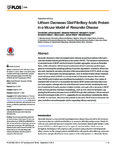Lithium Decreases Glial Fibrillary Acidic Protein in a Mouse Model of Alexander Disease
| dc.contributor.author | LaPash Daniels, CM | |
| dc.contributor.author | Paffenroth, E | |
| dc.contributor.author | Austin, EV | |
| dc.contributor.author | Glebov, Konstantin | |
| dc.contributor.author | Lewis, D | |
| dc.contributor.author | Walter, J | |
| dc.contributor.author | Messing, A | |
| dc.date.accessioned | 2019-01-30T12:50:13Z | |
| dc.date.available | 2019-01-30T12:50:13Z | |
| dc.date.issued | 2015-09-17 | |
| dc.identifier.issn | 1932-6203 | |
| dc.identifier.issn | 1932-6203 | |
| dc.identifier.other | ARTN e0138132 | |
| dc.identifier.uri | http://hdl.handle.net/10026.1/13241 | |
| dc.description.abstract |
Alexander disease is a fatal neurodegenerative disease caused by mutations in the astrocyte intermediate filament glial fibrillary acidic protein (GFAP). The disease is characterized by elevated levels of GFAP and the formation of protein aggregates, known as Rosenthal fibers, within astrocytes. Lithium has previously been shown to decrease protein aggregates by increasing the autophagy pathway for protein degradation. In addition, lithium has also been reported to decrease activation of the transcription factor STAT3, which is a regulator of GFAP transcription and astrogliogenesis. Here we tested whether lithium treatment would decrease levels of GFAP in a mouse model of Alexander disease. Mice with the Gfap-R236H point mutation were fed lithium food pellets for 4 to 8 weeks. Four weeks of treatment with LiCl at 0.5% in food pellets decreased GFAP protein and transcripts in several brain regions, although with mild side effects and some mortality. Extending the duration of treatment to 8 weeks resulted in higher mortality, and again with a decrease in GFAP in the surviving animals. Indicators of autophagy, such as LC3, were not increased, suggesting that lithium may decrease levels of GFAP through other pathways. Lithium reduced the levels of phosphorylated STAT3, suggesting this as one pathway mediating the effects on GFAP. In conclusion, lithium has the potential to decrease GFAP levels in Alexander disease, but with a narrow therapeutic window separating efficacy and toxicity. | |
| dc.format.extent | e0138132-e0138132 | |
| dc.format.medium | Electronic-eCollection | |
| dc.language | en | |
| dc.language.iso | eng | |
| dc.publisher | Public Library of Science (PLoS) | |
| dc.subject | Alexander Disease | |
| dc.subject | Animals | |
| dc.subject | Astrocytes | |
| dc.subject | Autophagy | |
| dc.subject | Brain | |
| dc.subject | Disease Models, Animal | |
| dc.subject | Female | |
| dc.subject | Gene Knock-In Techniques | |
| dc.subject | Glial Fibrillary Acidic Protein | |
| dc.subject | Lithium | |
| dc.subject | Male | |
| dc.subject | Mice | |
| dc.subject | STAT3 Transcription Factor | |
| dc.subject | alpha-Crystallin B Chain | |
| dc.title | Lithium Decreases Glial Fibrillary Acidic Protein in a Mouse Model of Alexander Disease | |
| dc.type | journal-article | |
| dc.type | Journal Article | |
| dc.type | Research Support, N.I.H., Extramural | |
| dc.type | Research Support, Non-U.S. Gov't | |
| plymouth.author-url | https://www.webofscience.com/api/gateway?GWVersion=2&SrcApp=PARTNER_APP&SrcAuth=LinksAMR&KeyUT=WOS:000361769400057&DestLinkType=FullRecord&DestApp=ALL_WOS&UsrCustomerID=11bb513d99f797142bcfeffcc58ea008 | |
| plymouth.issue | 9 | |
| plymouth.volume | 10 | |
| plymouth.publication-status | Published online | |
| plymouth.journal | PLOS ONE | |
| dc.identifier.doi | 10.1371/journal.pone.0138132 | |
| plymouth.organisational-group | /Plymouth | |
| plymouth.organisational-group | /Plymouth/Faculty of Health | |
| plymouth.organisational-group | /Plymouth/Faculty of Health/Peninsula Medical School | |
| plymouth.organisational-group | /Plymouth/REF 2021 Researchers by UoA | |
| plymouth.organisational-group | /Plymouth/REF 2021 Researchers by UoA/UoA01 Clinical Medicine | |
| plymouth.organisational-group | /Plymouth/Users by role | |
| plymouth.organisational-group | /Plymouth/Users by role/Academics | |
| dc.publisher.place | United States | |
| dcterms.dateAccepted | 2015-08-25 | |
| dc.identifier.eissn | 1932-6203 | |
| dc.rights.embargoperiod | Not known | |
| rioxxterms.versionofrecord | 10.1371/journal.pone.0138132 | |
| rioxxterms.licenseref.uri | http://www.rioxx.net/licenses/all-rights-reserved | |
| rioxxterms.licenseref.startdate | 2015 | |
| rioxxterms.type | Journal Article/Review |


